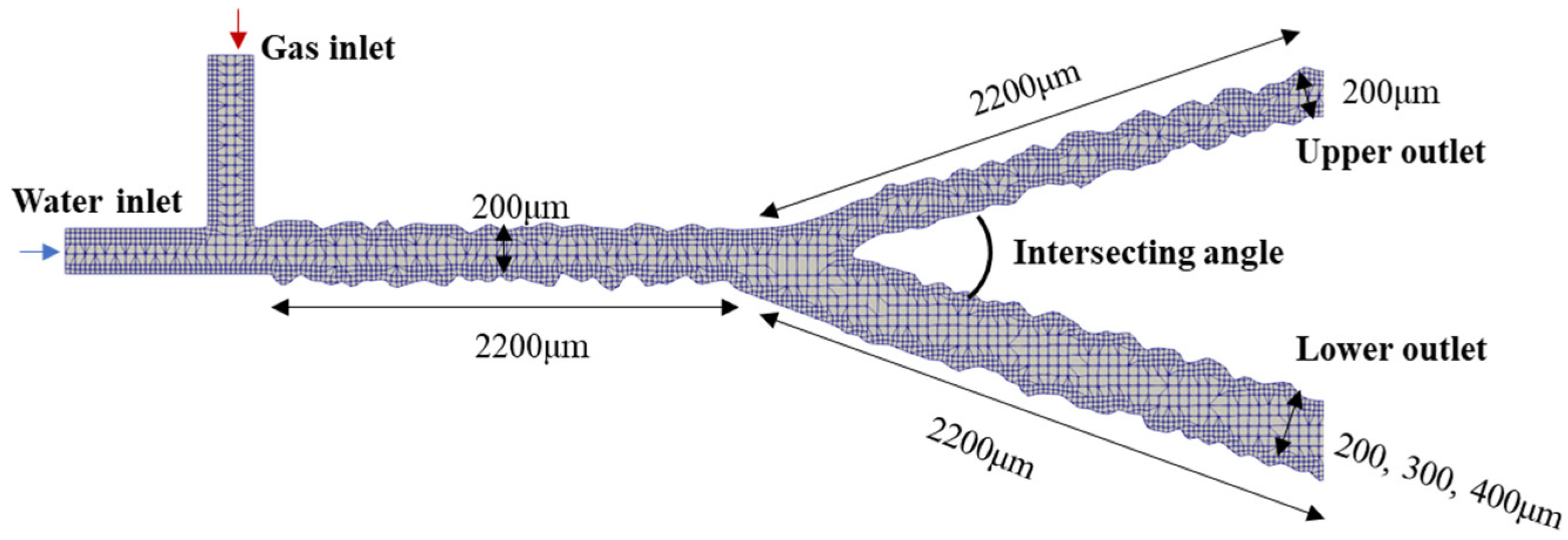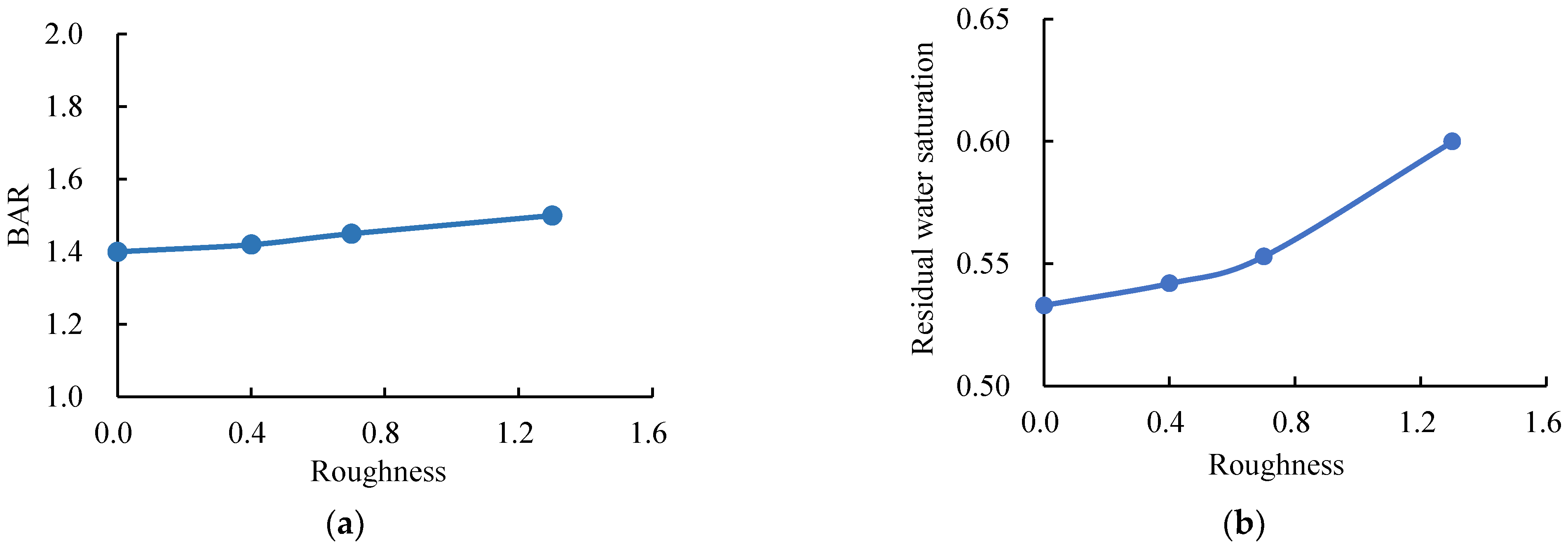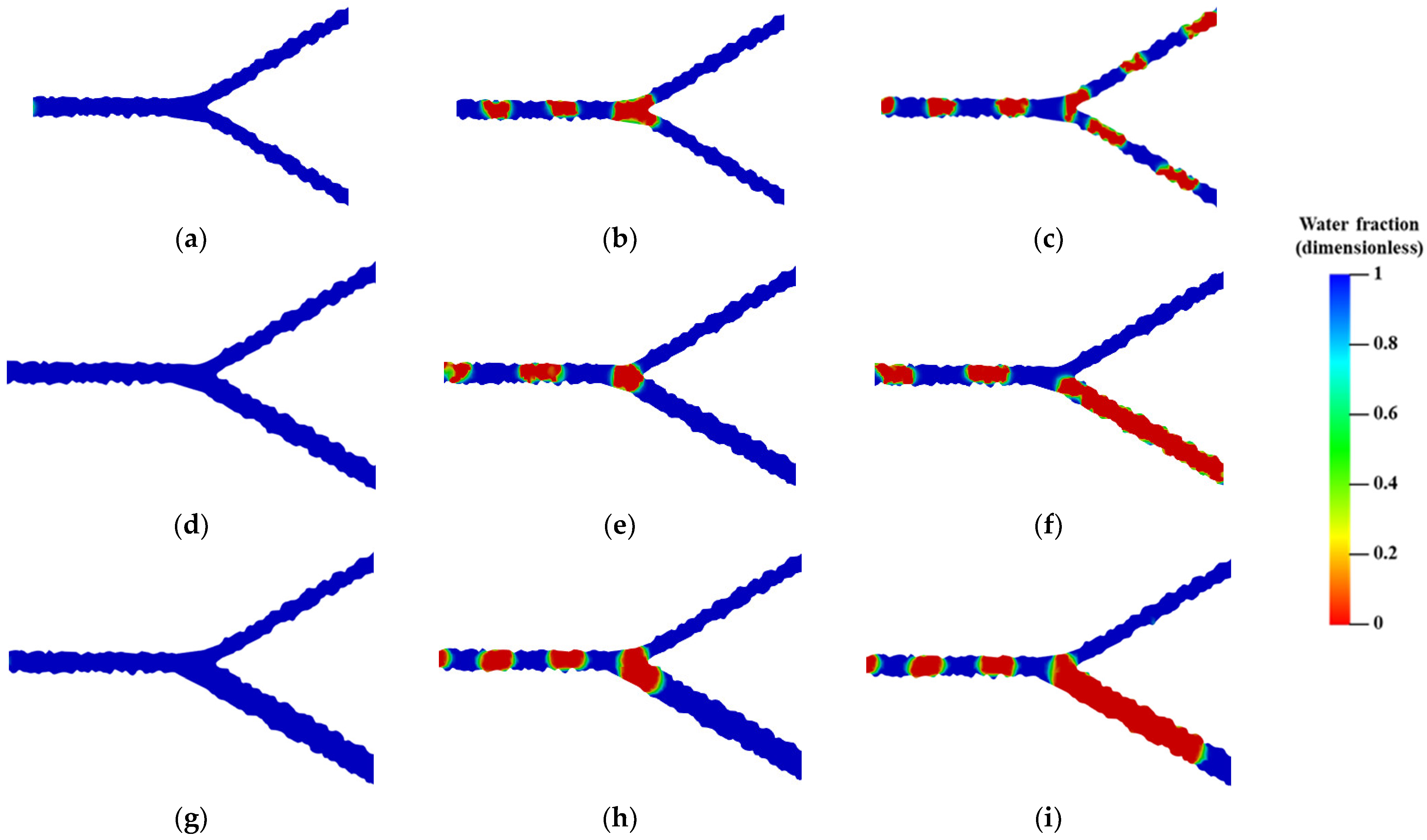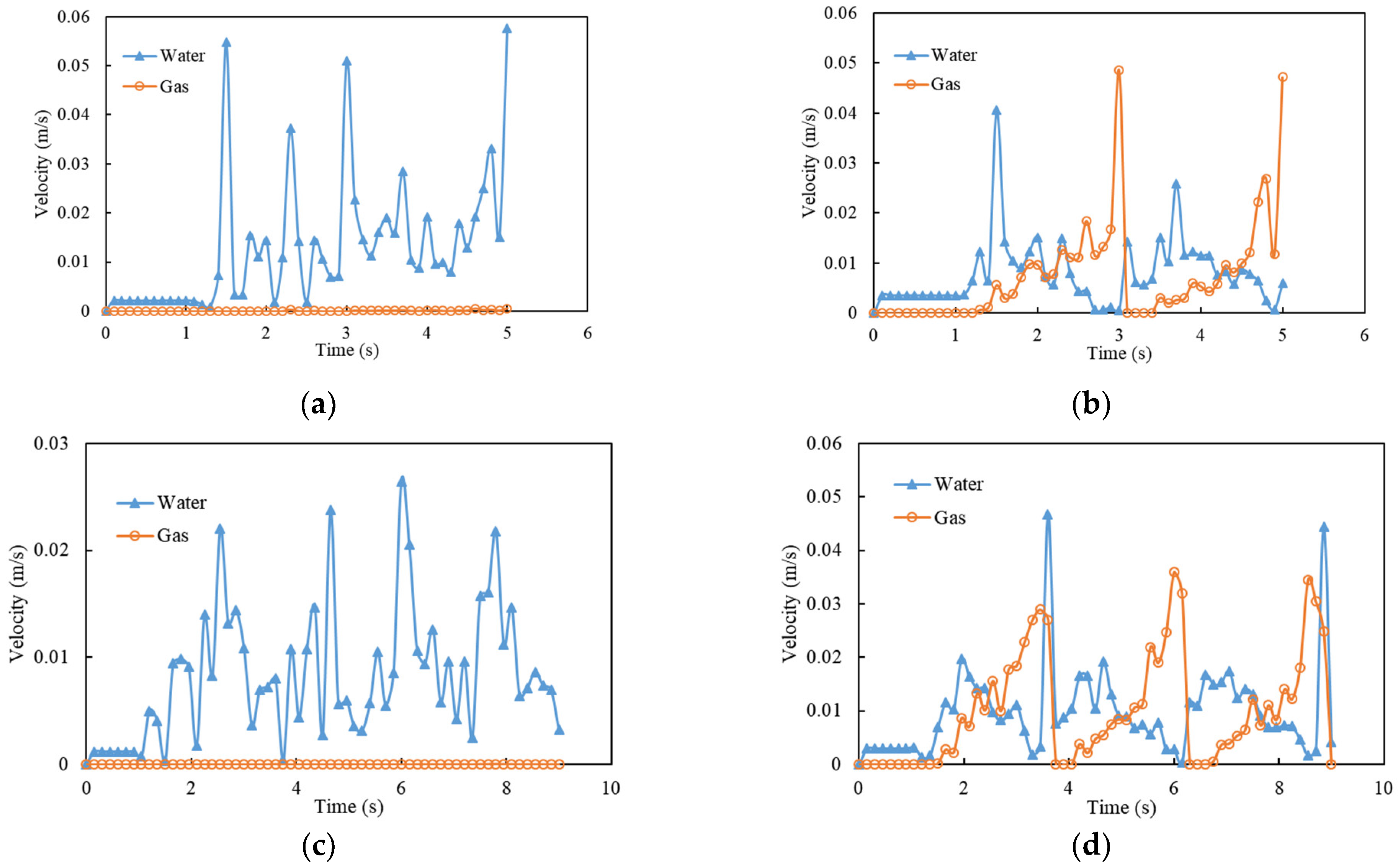Pore-Scale Simulation of Gas and Water Two-Phase Flow in Rough-Walled Fractures Using the Volume of Fluid Method
Abstract
:1. Introduction
2. Methods
2.1. Numerical Simulation Method for Two-Phase Flow
2.2. Validity Test of the VOF Method
2.3. Simulation of Gas/Water Flow in Rough-Walled Fracture Models
2.3.1. Single-Fracture Model
2.3.2. Y-Shaped Fracture Junction Model
3. Results and Discussion
3.1. Validation of the VOF Method
3.2. Gas/Water Flow Simulations in Rough-Walled Single-Fracture Models
3.2.1. Effect of Roughness
3.2.2. Effect of the Tortuosity
3.2.3. Effect of Gas/Water Ratio
3.2.4. Effect of Total Flow Rate
3.3. Gas/Water Flow Simulations in Rough-Walled Y-Shaped Junction Models
3.3.1. Effect of Aperture Ratio on the Phase Distribution
3.3.2. Effect of Intersecting Angle and Flow Rate on the Phase Distribution
4. Conclusions
Author Contributions
Funding
Conflicts of Interest
References
- Zhang, J.; Zhang, B.; Xu, S.; Feng, Q.; Zhang, X.; Elsworth, D. Interpretation of Gas/Water Relative Permeability of Coal Using the Hybrid Bayesian-Assisted History Matching: New Insights. Energies 2021, 14, 626. [Google Scholar] [CrossRef]
- Zhang, J.; Feng, Q.; Zhang, X.; Hu, Q.; Yang, J.; Wang, N. A Novel Data-Driven Method to Estimate Methane Adsorption Isotherm on Coals Using the Gradient Boosting Decision Tree: A Case Study in the Qinshui Basin, China. Energies 2020, 13, 5369. [Google Scholar] [CrossRef]
- Yan, X.; Sun, H.; Huang, Z.; Liu, L.; Wang, P.; Zhang, Q.; Yao, J. Hierarchical Modeling of Hydromechanical Coupling in Fractured Shale Gas Reservoirs with Multiple Porosity Scales. Energy Fuels 2021, 35, 5758–5776. [Google Scholar] [CrossRef]
- Zhu, S.; Salmachi, A. Flowing Material Balance and Rate-Transient Analysis of Horizontal Wells in Under-Saturated Coal Seam Gas Reservoirs: A Case Study from the Qinshui Basin, China. Energies 2021, 14, 4887. [Google Scholar] [CrossRef]
- Ming, Y.; Liu, J.; Liu, J.; Liu, Z.; Elsworth, A. Effect of adsorption-induced matrix swelling on coal permeability evolution of micro-fracture with the real geometry. Petrol. Sci. 2021, 18, 1143–1152. [Google Scholar]
- Yang, R.; Li, G.; Qin, X.; Huang, Z.; Li, J.; Sheng, M.; Wang, B. Productivity enhancement in multilayered coalbed methane reservoirs by radial borehole fracturing. Petrol. Sci. 2022, in press.
- Yang, Y.; Xu, Q.; Li, X.; Zhang, L.; Lan, X.; Wang, J.; Zhang, K.; Sun, H.; Zhang, L.; Yao, J. Pore-scale simulation of gas-water two-phase flow in volcanic gas reservoir based on Volume of Fluid method. J. Nat. Gas Sci. Eng. 2022, 106, 104733. [Google Scholar] [CrossRef]
- Zhang, Q.; Yan, X.; Shao, J. Fluid flow through anisotropic and deformable double porosity media with ultra-low matrix permeability: A continuum framework. J. Petrol. Sci. Eng. 2021, 200, 108349. [Google Scholar] [CrossRef]
- Zhang, Q.; Yan, X.; Li, Z. A mathematical framework for multiphase poromechanics in multiple porosity media. Comput. Geotech. 2022, 146, 104728. [Google Scholar] [CrossRef]
- Xu, K.; Zhu, P. A Microfluidic Investigation of the Synergistic Effect of Nanoparticles and Surfactants in Macro-Emulsion-Based Enhanced Oil Recovery. SPE J. 2017, 22, 459. [Google Scholar] [CrossRef]
- Mansour, M.; Kawahara, A.; Sadatomi, M. Experimental investigation of gas–non-Newtonian liquid two-phase flows from T-junction mixer in rectangular microchannel. Int. J. Multiph. Flow. 2015, 72, 263–274. [Google Scholar] [CrossRef]
- Wang, L.; Yang, S.; Peng, X.; Deng, H.; Meng, Z.; Qian, K.; Wang, Z.; Lei, H. An improved visual investigation on gas–water flow characteristics and trapped gas formation mechanism of fracture–cavity carbonate gas reservoir. J. Nat. Gas Sci. Eng. 2018, 49, 213–226. [Google Scholar] [CrossRef]
- Chen, S.; Zhang, J.; Yin, D.; Cheng, X.; Jiang, N. Relative permeability measurement of coal microchannels using advanced microchip technology. Fuel 2021, 312, 122633. [Google Scholar] [CrossRef]
- Gerami, A.; Mostaghimi, P.; Armstrong, R.; Zamani, A.; Warkiani, M. A microfluidic framework for studying relative permeability in coal. Int. J. Coal Geol. 2016, 159, 183–193. [Google Scholar] [CrossRef]
- Xie, C.; Raaeini, A.; Wang, Y.; Blunt, M.; Wang, M. An improved pore-network model including viscous coupling effects using direct simulation by the lattice Boltzmann method. Adv. Water Resour. 2017, 100, 26–34. [Google Scholar] [CrossRef]
- Raeini, A.; Blunt, J.; Bijeljic, B. Direct simulations of two-phase flow on micro-CT images of porous media and upscaling of pore-scale forces. Adv. Water Resour. 2014, 74, 116–126. [Google Scholar] [CrossRef]
- Yang, Y.; Wang, K.; Zhang, L.; Sun, H.; Ma, J. Pore-scale simulation of shale oil flow based on pore network model. Fuel 2019, 251, 683–692. [Google Scholar] [CrossRef]
- Wang, S.; Feng, Q.; Javadpour, F. Multiscale modeling of gas transport in shale matrix: An integrated study of molecular dynamics and rigid-pore-network model. SPE J. 2020, 25, 1416–1442. [Google Scholar] [CrossRef]
- Wang, S.; Feng, Q.; Dong, Y.; Han, X.; Wang, S. A dynamic pore-scale network model for two-phase imbibition. J. Nat. Gas Sci. Eng. 2015, 26, 118–129. [Google Scholar] [CrossRef]
- Li, X.; Wei, W.; Wang, L. A new method for evaluating the pore structure complexity of digital rocks based on the relative value of fractal dimension. Mar. Petrol. Geol. 2022, 141, 105694. [Google Scholar] [CrossRef]
- Yang, Y.; Zhou, Y.; Blunt, M.J.; Yao, J.; Cai, J. Advances in multiscale numerical and experimental approaches for multiphysics problems in porous media. Adv. Geo-Energy Res. 2021, 5, 233–238. [Google Scholar] [CrossRef]
- Cha, L.; Xie, C.; Feng, Q.; Balhoff, M. Geometric criteria for the snap-off of a non-wetting droplet in pore-throat channels with rectangular cross-sections. Water Resour. Res. 2021, 57, e2020WR029476. [Google Scholar] [CrossRef]
- Farahani, M.V.; Nezhad, M.M. On the effect of flow regime and pore structure on the flow signatures in porous media. Phys. Fluids 2022, 34, 115139. [Google Scholar] [CrossRef]
- Cha, L.; Feng, Q.; Wang, S.; Xu, S.; Xie, C. Pore-Scale Modeling of Immiscible Displacement in Porous Media: The Effects of Dual Wettability. SPE J. 2022, 1–12. [Google Scholar] [CrossRef]
- Tariq, A.; Liu, Z. Heat transfer and friction factor correlations for slip gaseous fluid flow in confined porous medium with pore-scale LBM modelling. Int. J. Therm. Sci. 2022, 173, 107382. [Google Scholar] [CrossRef]
- Feng, Q.; Cha, L.; Dai, C.; Zhao, G.; Wang, S. Effect of particle size and concentration on the migration behavior in porous media by coupling computational fluid dynamics and discrete element method. Powder Technol. 2020, 360, 704–714. [Google Scholar] [CrossRef]
- Qin, X.; Cai, J.; Zhou, Y.; Kang, Z. Lattice Boltzmann simulation and fractal analysis of effective thermal conductivity in porous media. Appl. Therm. Eng. 2020, 180, 115562. [Google Scholar] [CrossRef]
- Wang, Z.; Chen, L.; Wei, H.; Dai, Z.; Kang, Q.; Tao, W. Pore-scale study of mineral dissolution in heterogeneous structures and deep learning prediction of permeability. Phys. Fluids 2022, 34, 116609. [Google Scholar] [CrossRef]
- Yang, Y.; Cai, S.; Yao, J.; Zhong, J.; Zhang, K.; Song, W. Pore-scale simulation of remaining oil distribution in 3D porous media affected by wettability and capillarity based on volume of fluid method. Int. J. Multiph. Flow 2021, 143, 103746. [Google Scholar] [CrossRef]
- Kumar, R.; Premachandran, B. A coupled level set and volume of fluid method for three dimensional unstructured polyhedral meshes for boiling flows. Int. J. Multiph. Flow 2022, 156, 104207. [Google Scholar] [CrossRef]
- Sacher, J.; Repke, J. Development of a mesoscale model for the gas phase fluid dynamics in structured packings based on fundamental experiments and CFD investigations. Chem. Eng. Res. Des. 2019, 147, 430–442. [Google Scholar] [CrossRef]
- Li, J.; Zhengsong, Q.; Zhong, H.; Zhao, X.; Huang, W. Coupled CFD-DEM analysis of parameters on bridging in the fracture during lost circulation. J. Petrol. Sci. Eng. 2020, 184, 106501. [Google Scholar] [CrossRef]
- Zhang, G.; Marte, G.; Li, M. A coupled CFD-DEM approach to model particle-fluid mixture transport between two parallel plates to improve understanding of proppant micromechanics in hydraulic fractures. Powder Technol. 2017, 308, 235–248. [Google Scholar] [CrossRef]
- Song, R.; Wang, Y.; Liu, J.J.; Cui, M.M.; Ranjith, P.G. Pore scale investigation on scaling-up micro-macro capillary number and wettability on trapping and mobilization of residual fluid. J. Contam. Hydrol. 2019, 225, 103499. [Google Scholar]
- Yang, N.; Wu, Z.; Chen, J.; Wang, Y.; Li, J. Multi-scale analysis of gas–liquid interaction and CFD simulation of gas–liquid flow in bubble columns. Chem. Eng. Sci. 2011, 86, 3212–3222. [Google Scholar] [CrossRef]
- Huang, X.; Zhang, L.; Zhang, R.; Chen, X.; Zhao, Y.; Yuan, S. Numerical simulation of gas-liquid two-phase flow in the micro-fracture networks in fractured reservoirs. J. Nat. Gas Sci. Eng. 2021, 94, 104101. [Google Scholar] [CrossRef]
- Lafmejani, S.; Olesen, A.; Kær, S. VOF modelling of gas-liquid flow in PEM water electrolysis cell micro-channels. Int. J. Hydrogen Energy 2017, 42, 16333–16344. [Google Scholar] [CrossRef] [Green Version]
- Akhlaghi, M.; Mohammadi, V.; Nouri, N.M.; Taherkhani, M.; Karimi, M. Multi-Fluid VoF model assessment to simulate the horizontal air–water intermittent flow. Chem. Eng. Res. Des. 2019, 52, 48–59. [Google Scholar] [CrossRef]
- Saeedipour, M.; Schneiderbauer, S. Favre-filtered LES-VOF of two-phase flows with eddy viscosity-based subgrid closure models: An a-posteriori analysis. Int. J. Multiph. Flow. 2021, 144, 103780. [Google Scholar] [CrossRef]
- Huang, H.; Meakin, P.; Liu, M. Computer simulation of two-phase immiscible fluid motion in unsaturated complex fractures using a volume of fluid method. Water Resour. Res. 2005, 41, 2179–2187. [Google Scholar] [CrossRef]
- Woerner, M. Numerical modeling of multiphase flows in microfluidics and micro process engineering: A review of methods and applications. Microfluid. Nanofluid. 2012, 12, 841–886. [Google Scholar] [CrossRef]
- Soh, G.Y.; Yeoh, G.H.; Timchenko, V. An algorithm to calculate interfacial area for multiphase mass transfer through the Volume-Of-Fluid method. Int. J. Heat Mass Transf. 2016, 100, 573–581. [Google Scholar] [CrossRef]
- Mahoney, S.A.; Rufford, T.E.; Johnson, D.; Dmyterko, A.S.; Rodrigues, S.; Esterle, J.; Rudolph, V.; Steel, K.M. The effect of rank, lithotype and roughness on contact angle measurements in coal cleats. Int. J. Coal Geol. 2017, 179, 302–315. [Google Scholar] [CrossRef]
- Akhondzadeh, H.; Keshavarz, A.; Awan, F.U.R.; Zamani, A.; Iglauer, S.; Lebedev, M. Coal cleat network evolution through liquid nitrogen freeze-thaw cycling. Fuel 2022, 314, 123069. [Google Scholar] [CrossRef]
- Jin, Y.; Zheng, J.; Liu, X.; Pan, J.; Liu, S. Control mechanisms of self-affine, rough cleat networks on flow dynamics in coal reservoir. Energy 2019, 189, 116149. [Google Scholar] [CrossRef]
- Mostaghimi, P.; Armstrong, R.T.; Gerami, A.; Hu, Y.; Jing, Y.; Kamali, F.; Liu, M.; Liu, Z.; Lu, X.; Ramandi, H.L.; et al. Cleat-scale characterisation of coal: An overview. J. Nat. Gas. Sci. Eng. 2017, 39, 143–160. [Google Scholar] [CrossRef]
- Akhondzadeh, H.; Keshavarz, A.; Al-Yaseri, A.Z.; Ali, M.; Awan, F.U.; Wang, X.; Yang, Y.; Iglauer, S.; Lebedev, M. Pore-scale analysis of coal cleat network evolution through liquid nitrogen treatment: A Micro-Computed Tomography investigation. Int. J. Coal Geol. 2020, 219, 103370. [Google Scholar] [CrossRef]
- Babadagli, T.; Raza, S.; Ren, X.; Develi, K. Effect of surface roughness and lithology on the water–gas and water–oil relative permeability ratios of oil-wet single fractures. Int. J. Multiph. Flow 2015, 75, 68–81. [Google Scholar] [CrossRef]
- Wang, M.; Chen, Y.; Ma, G.; Zhou, J.; Zhou, C. Influence of surface roughness on non-linear flow behaviors in 3D self-affine rough fractures: Lattice Boltzmann simulations. Adv. Water Resour. 2016, 96, 373–388. [Google Scholar] [CrossRef]
- Maghsoudy, S.; Bakhtiari, O.; Maghsoudy, S. Tortuosity prediction and investigation of fluid flow behavior using pore flow approach in heap leaching. Hydrometallurgy 2022, 211, 105868. [Google Scholar] [CrossRef]
- Muzemder, A.; Singh, K. Intra-pore tortuosity and diverging-converging pore geometry controls on flow enhancement due to liquid boundary slip. J. Hydrol. 2021, 598, 126475. [Google Scholar] [CrossRef]
- Lu, Y.; Liu, D.; Cai, Y.; Gao, C.; Jia, Q.; Zhou, Y. AFM measurement of roughness, adhesive force and wettability in various rank coal samples from Qinshui and Junggar basin, China. Fuel 2022, 317, 123556. [Google Scholar] [CrossRef]
- Hou, J.; Lin, S.; Zhang, M.; Li, W. Salinity, temperature and pressure effect on hydrogen wettability of carbonate rocks. Int. J. Hydrogen Energy, 2022; in press. [Google Scholar] [CrossRef]
- Liu, Y.; Berg, S.; Ju, Y.; Wei, W.; Kou, J.; Cai, J. Systematic investigation of corner flow impact in forced imbibition. Water Resour. Res. 2022, 58, e2022WR0. [Google Scholar] [CrossRef]


















| Parameter | Base Value | Range |
|---|---|---|
| Roughness | 0.4 | 0, 0.4, 0.7, 1.3 |
| Tortuosity | 1 | 1, 1.1, 1.3, 1.5 |
| Flow rate (10−3 m/s) | 4 | 0.2, 2, 4, 8 |
| Gas/water ratio | 1:1 | 1:9, 1:1, 4:1, 9:1 |
Publisher’s Note: MDPI stays neutral with regard to jurisdictional claims in published maps and institutional affiliations. |
© 2022 by the authors. Licensee MDPI, Basel, Switzerland. This article is an open access article distributed under the terms and conditions of the Creative Commons Attribution (CC BY) license (https://creativecommons.org/licenses/by/4.0/).
Share and Cite
Zhu, Q.; Yang, Y.; Zhang, X.; Wang, S.; Yang, J.; Zhang, J. Pore-Scale Simulation of Gas and Water Two-Phase Flow in Rough-Walled Fractures Using the Volume of Fluid Method. Energies 2022, 15, 9382. https://doi.org/10.3390/en15249382
Zhu Q, Yang Y, Zhang X, Wang S, Yang J, Zhang J. Pore-Scale Simulation of Gas and Water Two-Phase Flow in Rough-Walled Fractures Using the Volume of Fluid Method. Energies. 2022; 15(24):9382. https://doi.org/10.3390/en15249382
Chicago/Turabian StyleZhu, Qingzhong, Yanhui Yang, Xueying Zhang, Sanshuai Wang, Jinzhao Yang, and Jiyuan Zhang. 2022. "Pore-Scale Simulation of Gas and Water Two-Phase Flow in Rough-Walled Fractures Using the Volume of Fluid Method" Energies 15, no. 24: 9382. https://doi.org/10.3390/en15249382





